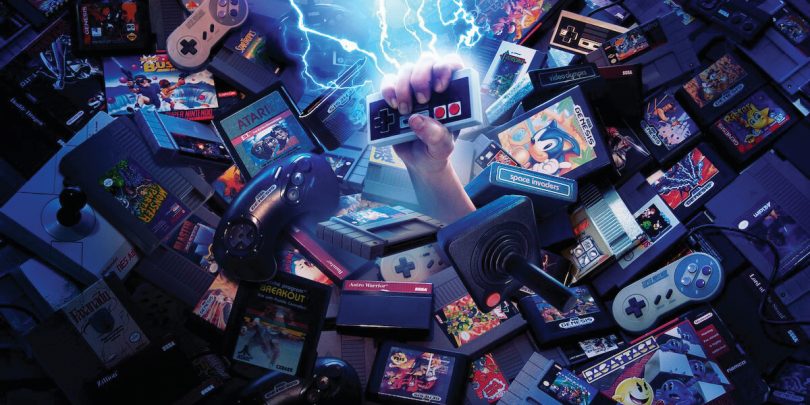Synopsis
Shoulder: The best time to know about Video Games is when one of their own is in running fast in cinemas
Film fanatics might know that the second feature-length movie featuring Sonic the Hedgehog is currently ‘running’ in cinemas all over the world, but not many know the significance of the lead character. The interdimensional creature who runs at supersonic speed has a history behind his creation, and Netflix’s documentary series High Score brings that history to you, as well as the evolution of the video games business.
High Score is not your run-of-the-mill kind of documentary that is prepared in one place, with comments from those available. In fact, the makers take a trip down memory lane as well as make you meet the famous people who had a hand in making video games popular. It features the interviews of those game developers who saw the future while living in the past and lets them tell you how did they come up with the idea for something that was not just non-existent but also insignificant at that time.
If you didn’t know that the video game market became huge in the 1980s and became more popular in the 1990s, then don’t worry since this documentary tells you all there is to know about video games. Some of the video games jargon might seem alien at first but it’s very essential to the development of video games. It begins with Pinball, which developed into Arcade Games which brought video games to the ‘players’, and how it evolved first into different levels of home video game consoles.
Watch the creator of the first-ever video game Space Invaders Tomohiro Nishikado talk about his creation as well as learn about the ‘dish’ that inspired Toru Iwatani to create Pac-Man. Add to that the comments from Nolan Bushnell, the co-founder of Atari, Inc, or Karen and Anderson Lawson who pioneered the use of a cartridge, and you have information about the business from those who mattered. Their comments will make you realize how something small became big and then went on to become huge, changing trends with their path-breaking steps.
The documentary series doesn’t have a host, but a narrator who doesn’t let you get bored for a second, so brilliant is the script. And if that narrator is Charles Martinet – the voice behind Mario in Super Mario Bros. video game – then that raises the fun level to unlimited. He might not be there to interview the celebrities who give their comments about the evolution of video games, but the way the producers integrate his narration with the comments is something people in this part of the world must learn.
High Score also brings some interesting anecdotes that usually aren’t known to people other than video game aficionados. It tells the audience that football legend John Madden finalized his deal with EA Sports on a train since he was afraid of flying. It also highlights the experience of networked gaming that might be considered a norm today but was a rarity back in the day. And yes, 1990s parents weren’t much different from their successors in the current era – they were outraged with the release of Street Fighter and Mortal Kombat as they didn’t agree with the violence it promoted.
Famous video games like Donkey Kong, Super Mario Bros., Street Fighter, and Final Fantasy are discussed at length in this six-part series where every episode deals with at least one video game developer. If one episode revolves around Nintendo, the other brings forward Atari, if role-playing games are discussed in one episode, then the rise of Sega is reserved for another episode. That way, each video game developer gets the importance it deserves even though it might seem dated to the newer audience who are least inquisitive about how things work.
And then there is Sega’s rise to the occasion with Sonic the Hedgehog, which helped Sega become a rival to Nintendo in no time. It also talks about the Crash of 1983, the ‘console wars’, and lets the viewers meet Chris Tang, the winner of the 1994 Sega World Championships, who at one time was considered a national-level celebrity for his feat. And if you have any questions about the evolution of your favorite game, you will find the answer within this limited series, which should be given an award just for being there.
That’s not all. The series also focuses on the artists, and designers besides the star players, to paint the real picture behind the struggle that wasn’t known to the players till now. Some people might claim that the series revolves more around Mario than other video games, but that’s not true because, without Mario, there wouldn’t be any video game culture anywhere in the world.
The aim of this documentary was to show to the world that behind every small step, there was a huge collaborative effort, and the same thing happened with the video games industry. It isn’t just limited to the video games consoles; the early computers, the handheld consoles, and stuff like the Game Boys also make an appearance here. Not only that, how these games were marketed when they were released, and how well they were received also make it an interesting watch.
What it is limited to are the US and Japan but that’s because these two countries played the biggest role in both developing and playing video games. High Score does well at explaining how games dethroned Comic Books and how they used the Comic Book culture to their advantage. A modern-day teenager might find some of the games, their plots, and their graphics laughable but without these games, the modern ones wouldn’t have existed. How the games grew from Spacewar! to Pong and finally to Sonic the Hedgehog will interest the viewers as much as it will entice those who have played the games.
On the whole, High Scores lets parents be kids and kids be children for its duration since it tackles something that is close to their hearts. The opposition video game creators faced are discussed here as well as the cultural jump East Asian countries received when they became international. The viewers also get to know how those who modified the already-released games had a hand in taking video games forward, and what were the reasons that kicked off the transition from 2D to 3D computer graphics. Thanks to this documentary, nothing escapes its sight, just like the Pac-Man … or was it Sonic the Hedgehog?







